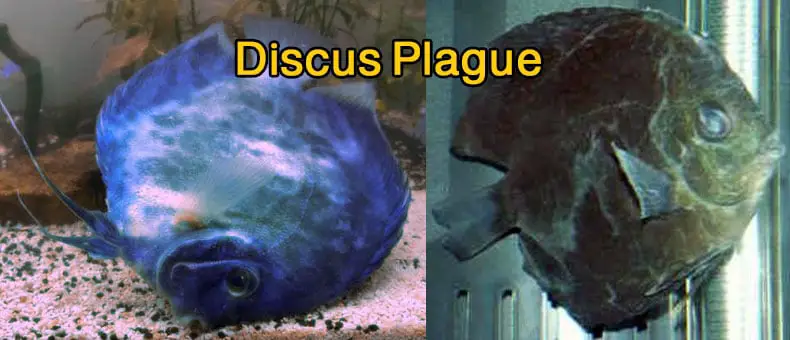
Discus plague or black disease (also known as death disease) is a deadly, highly contagious viral condition that weakens the immune system of the fishes and renders them powerless against secondary attacks. discus within 3-5 days after exposure will start exhibiting the plague disease symptoms, and mature fish often suffers the most severe symptoms, dying within the first few days of the disease., in some cases, it is so hard to cure but in some cases, it can be cured.
Table of Contents
- Discus Plague Disease Symptoms
- Discus Plague Disease Details and Cause
- Discus Plague Disease Treatments steps
- [STEP1] – Quarantine Sick Discus
- [STEP2] – Increase Water Temperature
- [STEP3] – Increase Oxygine in Water
- [STEP4] – Do Water Changes
- [STEP5] – Clean Aquarium Filter
- [STEP6] – Check Your Water Parameters
- [STEP7] – Remove Nipping Fishes Before Treatment
- [STEP8] – Apply Antibacterial Treatment
- [STEP9] – Treat With De-Chlorinator
- [STEP10] – Add Antibiotic Medicine
- [STEP11] – Treat The Mucous Production
- [STEP12] – Use Oxidizing Agent Treatment
- [STEP13] – Add Salt To The Aquarium
- [STEP14] – Stop Feeding Yout fish When Not Needed
- [STEP15] – Seek A Professional Assistance
- Future Prevention Tips
- Conclusion
Discus Plague Disease Symptoms
- Infected fish experience rapid and sometimes heavy breathing up to 3 breaths per second during the first stages of the plague.
- Excessive production of mucus.
- Development of a slim coat like pealing snots on some areas of the skin.
- Due to a large amount of slim coats and protein, the water becomes cloudy and smelly.
- Hiding or hanging in a dark corner near the top or bottom of the tank.
- A flock of discus swimming up and down a corner of the tank for no reason.
- At the top or bottom of the tank, you see discus leaning to one side or another.
- Dark background color or general darkening in the Discus fish body.
- Shyness, loss of interest in feeding, or hiding behind aquarium decorations.
- Discus shows signs of stress.
- Increasing black spots and peppering on the discus skin.
- Fin rot is severe.
- Fin edges turning whitish and becomes rag as a result of secondary infections such as external fungi, parasites, and bacteria.
- Clamped fins.
- The Discus dart and twitch, rubbing and scratching against aquarium objects.
- The body muscle is visibly heavy and often comes off the discus.
- Suppressing immunity.
In less than 2 or 3 days, the virus will move from one tank to another and spread across the store or farm.
Discus Plague Disease Details and Cause
Aquarium hobbyist and discus breeder have been left baffled by the origin of the black disease since it came to light early in 1985’s in European discus hatcheries. Since then, hobbyist around the world has been on the mission to understand the plague’s origin and its ability to spread so fast in aquarium farms and tanks.
Theories were propounded, which at the end of the day were personal opinions of the hobbyist. However, assumptions were made that if what we call the herpes virus seem to be the cause of the black disease, then its point of origin would be from South American’s Cichlid’s many years before it was recognized as discus in the aquariums around the world.
Since very little scientific evidence exists about the discus plague, it is difficult to determine the origin of the plague. There are some signs and symptoms in infected fish that show that the Discus plague is probably a viral infection that affects the discus immune system.
How Is the Discus Plague Spread?
Discus plague can be spread from tank to tank, or from fish to fish because it is a highly contagious airborne viral disease that can be transmitted to water.
The wounds caused to the skin by the parasite allow bacterial to enter. So, fishes and tanks in the same house, room, or even building can be exposed to this black disease without coming in contact with each other or sharing the same equipment.
The black disease is typically introduced into an aquarium by a new fish, decorations, plants, or live food. Also, if you have the intention of introducing a discus that was once infected into a new tank of discus, please be aware of the transmission risk involve in this, and we advise against this process.
Is Discus Plague Disease Contagious?
Yes, discus plague disease is extremely contagious, and the reason being that once infected discus though healthy may still harbor the black disease virus for 6 months and, at such, should be kept in a separate tank. They are still contagious even after the signs of the plague are no more.
Discus Plague Disease Treatments steps
Since discus plague is a viral infection that attacks the fish immune system making it impossible to resist external secondary fungal or bacterial attacks and seeing that there is no cure or treatments for it, we can help the fish to be able to fight back and beat the black disease by boosting up their immunity and antibody to that certain subtype of black disease be it a bacterial, fungal, or other secondary infections.
Below are the 15 steps on how to go about discus plague disease treatments:
[STEP1] – Quarantine Sick Discus
Sick fish should be moved to a quarantine tank with treated water and proper conditions, and apply the below treatment for both aquariums the main and the hospital one.
[STEP2] – Increase Water Temperature
The water temperature should be increased up to 92º degrees Fahrenheit, which helps to boost the fish’s immune system and increase its metabolic function.
[STEP3] – Increase Oxygine in Water
The oxygen level in the tank should be adjusted with the help of air stone. Enough drop in the aquarium is sufficient to help affected fish breathe normally.
[STEP4] – Do Water Changes
Before adding the new dosage of the medicine, a 100% water change should be carried out every 24 hours; water change is key. Also, the tank should be cleaned properly.
[STEP5] – Clean Aquarium Filter
Aquarium filters should be properly checked and cleaned from time to time to ensure better performance.
[STEP6] – Check Your Water Parameters
Water conditions should be tested after every water change and treated to remove toxins from the main tank.
[STEP7] – Remove Nipping Fishes Before Treatment
Nipping fish of all kinds (such as serpae tetras, black widow tetras, tiger barbs, and angelfish, bettas, and guppies) should be removed before moving black disease in the aquarium.
[STEP8] – Apply Antibacterial Treatment
Antibacterial treatment solution should be used to disinfect the tank and kill all bacterial.
Medications like API General Cure Powder and Azoo Magic Disease treatment are some of the best examples for controlling and treating secondary infections caused by bacterial, fungal, or parasite.
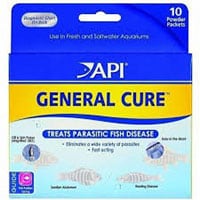

[STEP9] – Treat With De-Chlorinator
Use a specific solution like De-chlorinator in case of poisoning.
[STEP10] – Add Antibiotic Medicine
Antibiotics like Ciprofloxacin can help prevent, control, and treat many bacterial infections, which are the cause of death among black disease infected discus.
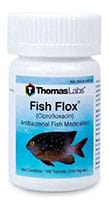
[STEP11] – Treat The Mucous Production
Then use antibiotics like Tetracycline, Chloramphenicol, Gentamycin will help fix fin deterioration as well as reduce the production of mucous on the skin.
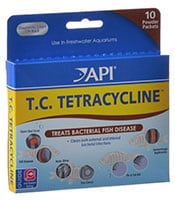
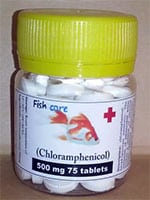
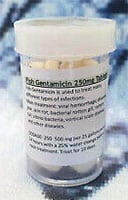
[STEP12] – Use Oxidizing Agent Treatment
Using oxidizing agent’s treatments like Potassium Permanganate will help to keep the bacterial count down, which also aids in your fish natural fight against the infestation.
[STEP13] – Add Salt To The Aquarium
Discus fish with stress should be treated with aquarium salt to relieve stress and improve recovery.
[STEP14] – Stop Feeding Yout fish When Not Needed
Until you see your bloated fish digest the food previously taken, do not feed them.
[STEP15] – Seek A Professional Assistance
Seek the help of a professional to find the right medicine for the infection.
Future Prevention Tips
The creation and maintenance of excellent water conditions are fundamental to the prevention of discus plague. Due to the type of discus being kept and the area of interest of the aquarist, the physical specifications of the water in an aquarium may differ. For instance, a wild Heckel in comparison to aquarium-raised strains is known to be more sensitive to organic waste and also prefers very warm soft, and acidic water.
As par future prevention of the discus plague death disease, one basic measure that should be strictly adhered to is to diligently follow the guidelines for aquarium set-up, maintenance, and quarantine procedures stated in the South American Cichlid care book. And since quarantine helps in the avoidance of problems like disease infection by isolating new Discus from the tank for a period of six weeks, it shouldn’t be taken lightly.
Also, the following should be considered:
- Resolve transportation and pressure issue by moving the fish first from a bag to a smaller tank before moving them to a huge aquarium.
- Discus should be fed with high quality feeds, and excess feeds should be removed immediately.
- Change dark-colored environment to white-colored environment
- When noticed, affected fish should be separated immediately
- Use a light blue environment and whitish bottom as your best-colored environment
- An approximate 30% water change weekly should be carried out regularly.
Conclusion
Discus plague, aka black disease, is real and is out there, and since there is no scientific proof to its existence, there are many theories out there by some professional who believes it is just a bunch of random diseases. That’s notwithstanding, the symptoms are real, and in this, all professionals can relate and at such proper care should be taken to monitor the discus in our tank and that proper measure should be adopted immediately as soon as you see the manifestation of any of the enumerated symptoms in your Discus.

Great article. New to discus. Have had mine for 2 months with no issues. Lots of research and following good advice. Thank you!
Thanks Sal for passing by, I am happy that you enjoyed the discus black death article.
What you have described here is now known to be hexamita (internal gastrointestinal parasite) almost 100% of the time. You can bring back a discus from the brink of death (ask me how I know!) using Metronidazole (Flagyl) available (at least in the USA) from Wattley Discus. Dissolve 500mg per 10 gallons (you DO have the fish isolated in a hospital tank, RIGHT???) every night for 10 nights. By day 7 your fish will be ravenously hungry and looking MUCH improved. By day 10, cured. Flagyl (allegedly – I’ve NEVER been able to confirm this) lasts for 8 hours in the water…so do your daily 20% water changes ONLY after 10 or so hours after dosing. Ultra-clean water and Metronidazole WILL cure your discus!!